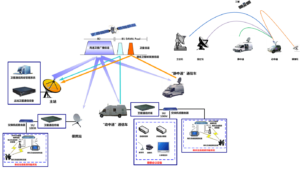Back to: Computer Studies JSS1
Welcome to class!
In today’s class, we shall be talking about satellite and internet global systems for mobile communication. Please enjoy the class!
Modern methods of Transmitting Information – satellite and internet global system for mobile communication

In the ever-expanding digital age, the ability to transmit information quickly and efficiently is crucial. This class note will explore two of the most significant modern methods of information transmission: satellite communication and the Internet global system for mobile communication (GSM).
Satellite Communication:
Satellites are artificial objects placed in orbit around the Earth. They act as communication relays, receiving signals from ground stations and transmitting them back to other ground stations or directly to users with satellite dishes.
Types of Satellite Communication:
Geostationary Orbit (GEO): These satellites orbit the Earth at an altitude of approximately 36,000 km, maintaining a stationary position relative to a specific point on Earth. Ideal for applications like television broadcasting and video conferencing.
Medium Earth Orbit (MEO): Satellites orbit at an altitude of 20,000 km, completing several orbits per day. Offer lower latency compared to GEO satellites and are suitable for mobile communication services.
Low Earth Orbit (LEO): Orbiting at altitudes between 200-2,000 km, these satellites complete multiple orbits per hour. They provide high-speed internet access with low latency, but require a larger number of satellites for continuous coverage.
Benefits:
- Global coverage, reaching even the most remote areas
- High bandwidth capacity for data transmission
- Disaster-resistant infrastructure
Limitations:
- High cost of launching and maintaining satellites
- Technical complexity of satellite communication systems
- Limited bandwidth compared to terrestrial networks in densely populated areas
II. Internet Global System for Mobile Communication (GSM):

GSM is a standardized digital cellular network used for mobile communication worldwide. It allows users to make voice calls, send text messages, and access the internet through mobile devices.
Components:
- Mobile Station (MS): This is the user’s mobile phone or other device.
- Base Station Transceiver System (BTS): This is the antenna tower that transmits and receives signals from mobile devices.
- Base Station Controller (BSC): This manages a group of BTSs and controls the handovers between them.
- Mobile Switching Center (MSC): This connects the GSM network to other networks, including the Internet.
Benefits:
- Global roaming capabilities
- Secure communication through encryption
- Scalability to accommodate a large number of users
- Wide range of services beyond voice calls, including text messaging, internet access, and multimedia applications
Limitations:
- Coverage may be limited in rural areas
- Mobile data speeds can vary depending on network congestion and user location
- Data plans can be expensive for heavy users
Both satellite communication and GSM play vital roles in the modern information age. Satellite communication is particularly valuable for reaching remote areas and providing high-bandwidth data transmission. GSM, on the other hand, offers widespread mobile communication and internet access to billions of people worldwide. The choice between the two technologies depends on the specific needs and requirements of the user.
We have come to the end of today’s class. I hope you enjoyed the class!
In case you require further assistance or have any questions, feel free to ask in the comment section below, and trust us to respond as soon as possible. Cheers!
Question Time:
- What are the potential future developments in satellite communication and GSM?
- How can satellite communication and GSM be used to address the digital divide?
- What are the ethical considerations of using satellite-based surveillance technologies?
